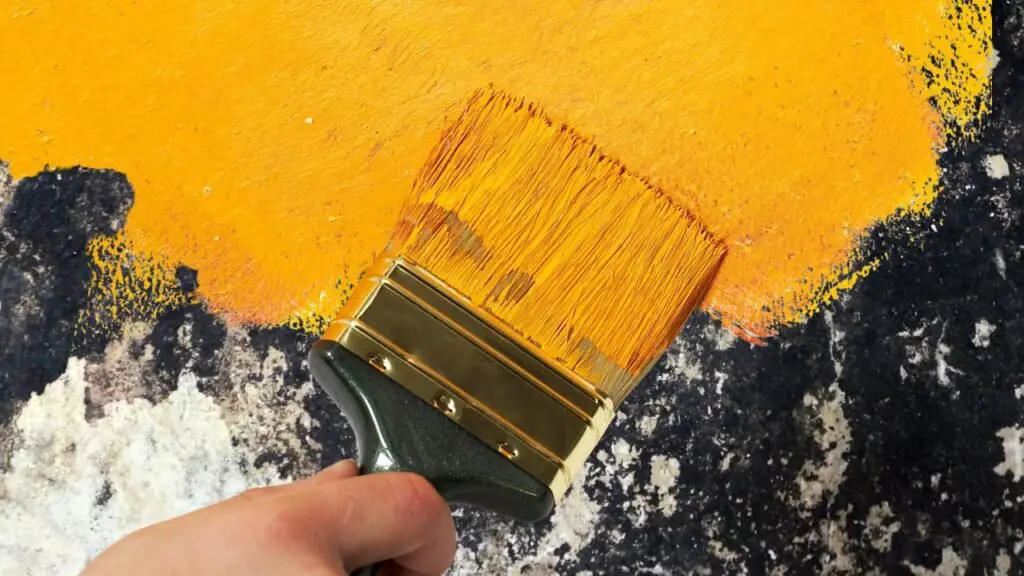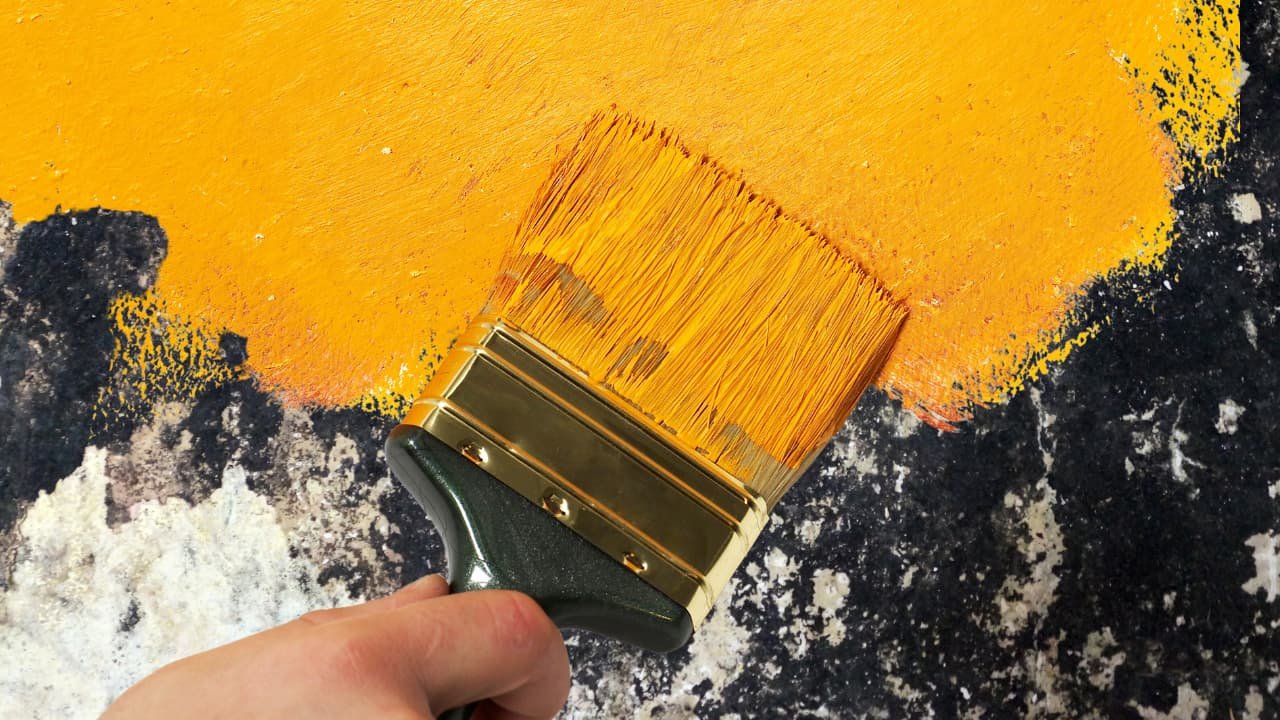Have you ever noticed a mold infestation in your home and wondered if painting over it could be the solution? If so, you’re not alone. However, before you grab that paintbrush, it’s crucial to understand the risks associated with this approach and explore effective remedies for dealing with mold growth.
In this blog post, we will unravel the potential hazards of concealing mold under the paint and delve into practical solutions for removing and preventing its recurrence.
Key Takeaways – Can You Paint Over Mold? 💭
- Painting over mold can have damaging effects and may not address the root cause of moisture that led to its growth, prolonging the risk of fungal infection.
- Effective mold removal requires identifying and eliminating the source of mold growth, cleaning with specialized solutions and tools, and using mold-resistant paints for prevention.
- Controlling humidity levels, ensuring proper ventilation, conducting regular inspections, and seeking professional remediation services when needed are essential in preventing future fungal infestation.
Table of Contents

Risks Of Painting Over Mold
Painting over mold can be extremely risky as it can result in health hazards from mold exposure and the damaging effects of a fungal infection.
Health Hazards Of Mold Exposure
Exposure to mold can lead to a variety of health issues, particularly for individuals with pre-existing respiratory conditions or weakened immune systems.
Mold thrives in moisture-rich environments and releases spores that contaminate indoor air quality, triggering allergic reactions and respiratory illnesses among occupants.
In more severe cases of mold infestation – especially when black molds like Stachybotrys chartarum are involved – the consequences can be far more serious. These toxic strains produce mycotoxins that cause neurological damage and compromise overall well-being.
Long-term exposure may result in chronic fatigue syndrome, memory loss, dizziness, headaches, anxiety and depression amongst other debilitating conditions.
Effects Of Painting Over Mold
Painting over mold may seem like a quick fix to cover mold up, but it can have damaging effects. Mold spores can continue to grow under the paint and spread throughout the area, leading to an even bigger infestation.
Covering up mold with paint also does not address the root cause of moisture that led to its growth, prolonging the risk of fungal infection. In addition, painted surfaces affected by mold may experience “bleed-through,” where the residual mold stains show through after painting.
Remedies For Mold Removal
Identifying and eliminating the source of mold growth is crucial to successful remediation, followed by cleaning with effective solutions and specialized tools.
Identifying The Source Of Mold Growth
Before attempting to remove mold, it is essential to identify the source of its growth. Mold only thrives in moisture-rich environments; thus, identifying and fixing water leaks is critical in preventing mold infestations.
In some cases, however, moisture buildup may be due to poor ventilation or high humidity levels. This can occur in areas such as bathrooms or kitchens with inadequate airflow.
Additionally, it is crucial to inspect hidden surfaces such as behind wallpaper or drywall where molds could exist without being noticed by a homeowner.
Cleaning Mold With Effective Solutions
To effectively clean mold, you will need to use specialized cleaning solutions that can break down the structure of the fungal growth and remove it from your surfaces.
Some effective solutions include hydrogen peroxide, bleach, vinegar, borax or baking soda.
When using bleach as a cleaning solution for mold removal, always ensure it is diluted correctly before application. Bleach is an effective sanitizer against fungal infection but can present health problems if it’s left on surfaces or not diluted properly.
Hydrogen peroxide is another excellent alternative to bleach in treating mildew without presenting risks associated with harsh chemicals.
Whichever cleaner you choose remember that the goal is to eliminate all traces of mold spores embedded within porous materials like drywall and lumber supplies before repainting over them using paint products designed for preventing future regrowth of molds.
Using Specialized Tools For Mold Removal
Mold removal can be a daunting task, especially if the infestation is extensive. However, with specialized tools, the process can be made more manageable and efficient. One of these tools is an air scrubber, which helps to eliminate mold spores from the air during cleaning.
HEPA vacuums are also useful in collecting and trapping tiny particles released into the air when cleaning.
Another essential tool for mold removal is a moisture meter, which helps identify areas with excess moisture that may encourage mold growth. Moisture meters help to ensure that all sources of moisture are identified and addressed during remediation.
Additionally, negative air machines can create negative pressure in contaminated areas to prevent mold spores from spreading to other parts of the building during cleanup.
Painting After Mold Removal
After successfully removing mold from surfaces, the next step is to prepare the area for painting by applying a Kilz primer or mold-killing paint and selecting moisture-resistant paints.
But that’s not all – there are essential precautions to take when painting after mold removal.
Preparing The Surface For Painting
Before painting after mold removal, it’s crucial to prepare the surface properly. Any remaining mold spores or moisture can lead to bleed-through and damage the new paint job.
First, ensure that the surface is completely dry and free of any debris. Use a mild soap solution and water to clean the area thoroughly, removing any dirt or grime.
Using a high-quality primer is necessary for ensuring that no trace of mold remains on the surface before painting. Consider using Kilz Primer as it is specially designed for mold remediation projects and prevents future growth by killing existing spores.
Applying multiple coats may be necessary depending on how severe the infestation was in order to achieve complete coverage.
Choosing Mold-Resistant Paints
When it comes to painting after mold removal, choosing the right type of paint is crucial. Mold-resistant paints are specially formulated to prevent mold growth and can be a smart investment in maintaining a healthy environment.
One popular brand of anti-mold paint that has been highly recommended by professionals is Kilz primer and mold killing paint. This paint contains a powerful fungicidal ingredient that effectively kills existing mold spores while preventing new ones from growing.
Additionally, painting with two coats of this product not only enhances the look of your exterior walls but also protects against future fungal infections.
Maintaining A Mold-Free Environment
To maintain a mold-free environment, it’s essential to control humidity levels and ensure proper ventilation. High humidity levels in your home can lead to moisture buildup, making it an ideal breeding ground for mold spores.
You can prevent this by using dehumidifiers or air conditioners to reduce the amount of moisture in the air.
It’s also important to conduct regular inspections of your home, particularly in areas that are prone to moisture accumulation like bathrooms and kitchens.
Cleaning up any leaks or spills immediately helps prevent water damage which could lead to mold growth. If you notice any signs of mold infestation despite taking these preventive measures, seek professional mold remediation services as soon as possible before the mold problem even gets worse.
Preventing Mold Growth
Controlling humidity levels, ensuring proper ventilation, conducting regular inspections, seeking professional mold remediation services, and using mold-resistant paint are all effective ways of preventing future fungal infestation.
Discover practical tips to keep your home or workspace mold-free.
Controlling Humidity Levels
Mold thrives in moist and humid environments, making controlling humidity levels an essential aspect of preventing mold growth. In areas with high humidity levels, such as bathrooms and basements, using exhaust fans or dehumidifiers can help regulate the moisture content in the air.
It’s also important to note that while low humidity levels aren’t ideal for mold growth, extremely dry conditions can cause other issues like cracking and warping in wooden structures or furniture.
Finding a balance between maintaining optimal humidity levels for human health and preventing mold growth is crucial for proper maintenance of your home or workplace.
Ensuring Proper Ventilation
Proper ventilation in attic space is critical in preventing mold growth. It allows moisture to escape, reducing the chances of mold and mildew accumulation.
If you live in a moist environment or have areas prone to dampness such as bathrooms, laundry rooms, and basements, ensure proper ventilation by using exhaust fans or opening windows when possible.
In addition, check that your HVAC system is working efficiently and regularly replace filters to keep circulation flowing smoothly. Make sure that vents are not blocked by furniture or other items so that air can flow freely throughout the room.
Conducting Regular Inspections
Regular inspections are crucial in the prevention and early detection of mold growth. During these inspections, it’s important to check for any signs of moisture, discoloration, or strange odors that could indicate a mold infestation.
Homeowners can conduct simple inspections themselves by using their senses to detect any unusual musty odor or visible discolorations on surfaces. However professional inspectors can identify potential issues which an average homeowner might miss.
Regular inspections will help you identify the source(s) of potential mold growth in your home enabling you to take necessary action before the situation worsens and becomes expensive to control.
Seeking Professional Mold Remediation Services
If you suspect that your home or business has a mold infestation, it is always advisable to seek professional mold remediation services.
Professional mold remediation experts have the necessary skills and equipment to identify the extent of the infestation and develop a comprehensive plan for its elimination.
They use specialized techniques such as HEPA-filtered vacuums, negative air chambers, and antimicrobial treatments to ensure the effective removal of all traces of mold spores.
Conclusion
In conclusion, painting over mold is a temporary fix that can lead to dangerous health hazards and further damage. The risks of mold infestation and its damaging effects cannot be ignored.
It is crucial to identify the source of moisture-rich environments causing the growth of mold and clean it using effective cleaning solutions or specialized tools for complete mold removal experts say.
Before painting after proper remediation, it is essential to prepare the surface and choose mold-resistant paints like Kilz primer or Mold-Killing paint that prevent bleed-through from existing stains.
Regular inspections, controlling humidity levels, and ensuring proper ventilation in high-risk areas such as bathrooms can help prevent future outbreaks.
FAQs:
Can you safely paint over mold without addressing the underlying issue of mold paint?
No, it is not safe to simply paint over mold without first addressing the source of the moisture that caused it in order to prevent further growth and potential health risks.
What are some common risks associated with painting over mold?
Painting over mold can cause the spores kill mold to spread further into your home’s air stream, potentially exacerbating any existing health problems related to allergies or respiratory issues and making cleanup more difficult later on.
How do professionals typically address mold before painting paint coating?
A professional may use specialized cleaning agents and techniques to remove as much of the existing mold as possible before applying an anti-fungal primer designed specifically for this purpose, followed by a coat of fresh paint once everything has been allowed adequate time to dry.
Is there anything I can do myself before repainting a room affected by black mold?
Some DIY options include using bleach or vinegar solutions (carefully!) on small areas while wearing protective gear such as gloves and masks, but these methods are generally not recommended for larger jobs or those involving particularly harmful strains of fungal growth due to their potentially hazardous nature if not handled correctly.

